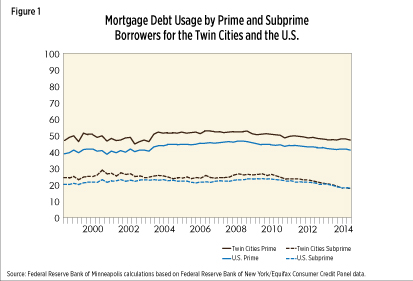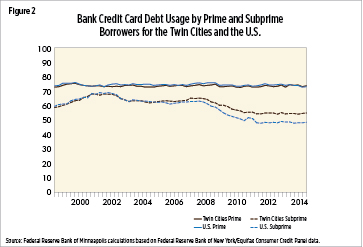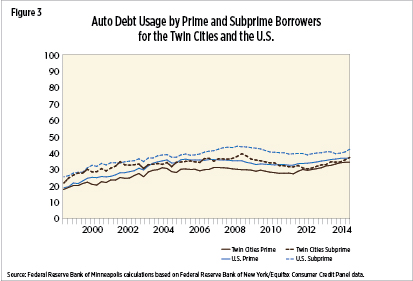Has lending to riskier borrowers made a comeback? Earlier this year, a number of news reports suggested that there is indeed a resurgence of subprime lending—that is, loans made or credit offered to borrowers with lower credit scores—following a pull-back during the Great Recession. According to these accounts, lenders had been relaxing their lending standards, particularly in mortgage lending, in response to sustained low interest rates and improvements in the economy and the housing market. Lenders weren’t only returning to riskier home mortgage lending, the accounts indicated, but to other lines of consumer credit, too, including bank credit cards and auto loans.
An analysis of the comeback question, based on data that track the actual borrowing behavior of consumers through their credit files, tells a different story, though. Overall, the data reveal no evidence of a subprime lending resurgence for mortgages and bank credit cards. But the data do reveal a recent increase in the percent of subprime borrowers holding auto debt. However, the increase in auto lending is broad-based and not just occurring among subprime borrowers, who make up a small share of the overall auto loan market.
Analyzing “subprime”
The word “subprime” generally refers to the heightened risk that a loan may enter into default, based in large part on a borrower’s credit characteristics, such as credit history and credit score. Because of the heightened credit risk, subprime loans generally have higher interest rates than conventional, or “prime,” loans. The analysis discussed here, which was performed by the Federal Reserve Bank of Minneapolis, identifies riskier, or subprime, borrowers using consumer credit scores as estimates of creditworthiness; it categorizes a consumer as subprime if his or her credit score is below 660. The credit scores and other data used are drawn from a dataset called the Federal Reserve Bank of New York/Equifax Consumer Credit Panel, which is a nationally representative sample of consumer credit information consisting of 5 percent of U.S. residents with a credit report that includes a Social Security Number.
The analysis focused on the percentage of prime and subprime borrowers with mortgage, bank credit card, and auto loan debt in the U.S. as a whole and in the largest population center in the Federal Reserve’s Ninth District—the Minneapolis-St. Paul metropolitan area—from 2000 to mid-2014. It is important to note that the share of consumers with subprime credit scores remained mostly unchanged over that period, dropping only a little since 2013. This consistency in the share of subprime borrowers over the years allows for straightforward comparisons of debt usage at different points in time. As of the second quarter of 2014, almost one-quarter of consumers in the Minneapolis-St. Paul area and just over one-third of all consumers in the nation had a credit score below 660.
Mortgages and credit cards down, autos up
The data show that nationally and in Minneapolis-St. Paul, a much smaller share of subprime borrowers than prime borrows holds a mortgage. (See Figure 1.) And while the percent of prime borrowers with mortgage debt declined slightly after 2008, by about 5 percentage points, the percent of subprime borrowers holding mortgage debt dropped even more over the same period, by roughly 8 percentage points. This downward trend for subprime borrowers holding mortgage debt shows no signs of a reversal.
With regard to balances owed on bank-issued, general purpose credit cards, which are the most widespread form of debt reported in consumer credit files, the share of prime borrowers with bank cards has remained stable over time. (See Figure 2.) The share of subprime borrowers with bank credit card debt first peaked in 2002 at roughly 70 percent, declined afterward, and then peaked again just prior to the Great Recession. Since then, the share of subprime borrowers with bank credit card debt has dropped, by 10 percentage points in the Minneapolis-St. Paul area and by 15 percentage points nationally. Since 2012, the usage of subprime bank credit card debt has remained largely unchanged.
While mortgage and bank card usage do not show a subprime revival, auto lending tells a different story. Overall, the share of consumer credit files with auto debt rose considerably prior to the Great Recession. (See Figure 3.) During the recession, the percentage of consumer credit files with auto debt declined, but it has trended upward since late 2011. The share of subprime borrowers holding auto debt saw a big drop after 2008, but the rebound that followed was strong and brought the prevalence of auto debt usage among subprime borrowers close to its pre-recession peaks.
Even though subprime auto debt has experienced a revival, the recent recovery appears to be more robust for prime borrowers, to the point where the percentage of prime borrowers with auto debt has risen above its 2007 peak. In addition, the post-2011 increase in the number of consumers holding auto debt was higher for prime borrowers than for subprime borrowers, both nationally and in the Minneapolis-St. Paul area. For example, the number of prime borrowers with auto debt increased by 20 percent after 2011, compared to 14 percent for subprime borrowers.
In summary, the much-discussed comeback of subprime lending appears to be limited to the auto loan market. Within this market the increase is less pronounced given the higher relative increase in prime auto lending during the same period.*/
A technology boost for subprime auto lending?
The increased availability of credit to subprime borrowers seeking an auto loan may be, in part, the result of new auto-tracking technologies. For example, lenders are installing GPS (Global Positioning System) devices in vehicles purchased by borrowers with riskier credit scores. A GPS device can transmit information about the vehicle’s precise location, making it easier for the lender to repossess the vehicle if necessary. Related devices can also be used to disable a car until it can be repossessed or until the delinquent borrower becomes current on his or her loan. These tools mitigate the risks associated with subprime lending by reducing default rates and increasing recovery rates when defaults do occur. As a result, they may be making lenders more willing to lend to subprime auto borrowers.
*/ Andrew Haughwout, Donghoon Lee, Joelle W. Scally, and Wilbert van der Klaauw, “Looking under the Hood of the Subprime Auto Lending Market,” Liberty Street Economics, Federal Reserve Bank of New York, August 14, 2014. Available at libertystreeteconomics.newyorkfed.org.
Michael works to advance the economic well-being of Indian Country and low- to moderate-income individuals, households, and communities. He has conducted research and published articles on affordable housing, community development corporations, homeownership disparities, and foreclosure patterns and mitigation efforts.








